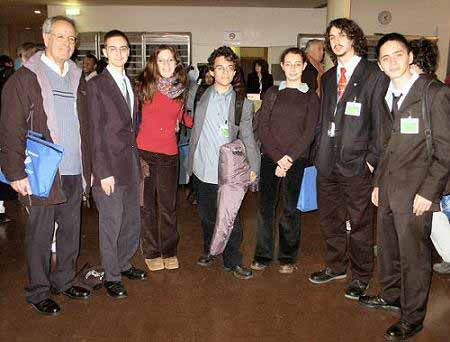On 15/01/2003-13, a conference was held at the UNESCO center in Paris to mark the opening of the year 2005, which was declared as the year of physics. In 2005 we celebrate the centenary of Albert Einstein's "wonderful year", in which he published four groundbreaking papers in three different fields.
Dikla Oren

Direct address to this page:
https://www.hayadan.org.il/wyplaunch0105.html
Paris, a community of physicists, Nobel laureates, lectures and discussions - sounds like a winning combination, doesn't it? on dates
13-15/01/2005 Physicists, students and high school students from around the world gathered at the UNESCO center in Paris to mark the opening of the year of physics. A delegation from Israel left on behalf of the Israel Physics Society, headed by Dr. Zvi Peltiel from the Weizmann Institute and Dr. Ofer Eyal from Ort Brauda College. The other members of the delegation were Yaakov Neiman, Yair Karmon, Anne Kesselman, Gilad Kaplan, Ilya Khivrich and the author of the article, Dikla Oren - all winners of Physics Olympiads and Physics Tournaments (the "vaults") or research workshop participants.
Why 2005, and why physics, you ask? It all started a century ago in Albert Einstein's "wonderful year". In 1905, Einstein, an official at the Swiss Patent Office, published four groundbreaking papers in three different fields.
The first was published in March 1905, in which Einstein dealt with the reaction of matter and electromagnetic radiation. Einstein came to the conclusion that light consists of discrete portions of energy, thus providing - among other things - an explanation for the photoelectric effect. This explanation contributed greatly to the development of quantum mechanics. Following this article, Albert Einstein won the Nobel Prize in 1921. The second article was published in May of the same year. He dealt with the limits of thermodynamics. According to his calculations, phenomena resulting from the movement of individual atoms can be observed using existing instrumentation, which thermodynamics is unable to handle. This is how Einstein "predicted" the phenomenon known today as "Brownian motion" without knowing that motion had already been observed but not explained. Einstein explained the constant movement of particles as an example of the movement of a grain in a liquid, thus contributing greatly to the development of the atomic theory of matter. He thereby also opened a new and fruitful field of physics known today as statistical mechanics.
The other two articles, published in June and September 1905, dealt with the topics of electromagnetics and motion or the relativity of time measurement and the meaning of simultaneity. In the first of the two articles, Einstein presented what we know today as the special theory of relativity. In the second article he continued to develop the ideas and presented the mass-energy equivalence in the most famous formula of all E=mc2.
Einstein had a busy year, therefore, and the United Nations chose to celebrate it by declaring 2005 as the Year of Physics. The opening conference included a number of interesting lectures in various fields such as games with molecules (some fun with carbon 60, the football molecule), quanta in everyday life (yes, there is such a thing, you can't imagine how much) and the wandering life of the elusive neutrino particles (while you read This sentence is passed through you by thousands of neutrino particles). The lectures were given by top scientists, including many Nobel laureates. The conference also included two discussions on "Physics and the socio-economic challenges in the twenty-first century" and "Perceptions of science and physics among the general public". A number of scientists participated in the discussions, who presented their opinions and answered the audience's questions.
Several key ideas accompanied the lectures and discussions. The most notable was the contribution of physics to technological development. Several lecturers emphasized the importance of translating research into practice, that is, into industrial achievements and products. An example of this, which was given in the lecture of Z. Alprov, winner of the 2000 Nobel Prize in Physics, was the developer of the transistor.
Another central idea woven throughout the entire conference was the integration between different fields of thought in science. One lecture specifically dealt with the connection between physics and chemistry over the years. Also, it is enough to look at the program to get an idea of the extent of the relationship between the various fields of science - the conference opening the year of physics included lectures both in the field of physics, such as lectures on cosmology, quantum mechanics, particle theories and forces, and lectures in fields such as life sciences, nanotechnology, nanophysics and education and instruction.
In conclusion, the conference certainly succeeded in stimulating the imagination and interest. It is important to remember that the purpose of the year of physics is not festive opening conferences (although they are respected in their place). The Year of Physics is a great opportunity to give more people a chance to see the beauty of this field. Anyone whose curiosity has been piqued is invited to visit the websites of various institutions such as the Weizmann Institute, the Givatayim Observatory, the Astronomical Club of Tel Aviv University and Hamada and take an interest in the various lectures and projects.
More about the activity of the Year of Physics in Israel
On the Weizmann Institute website
http://physicaplus.org.il/zope/home/en/100846630031/edu_wyp2005_en
More about Einstein
http://jnul.huji.ac.il/einstein/.index.html
http://www.westegg.com/einstein/#writings
http://www-groups.dcs.st-and.ac.uk/history/Mathematicians/Einstein.html
http://www.aip.org/history/einstein/essay-photoelectric.htm
Einstein knew
Physics expert
https://www.hayadan.org.il/BuildaGate4/general2/data_card.php?Cat=~~~77239105~~~95&SiteName=hayadan
